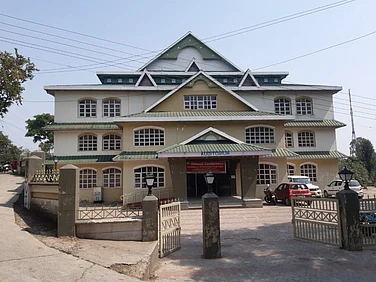On March 24, 2020, Imanul Haq, 26, a migrant labourer living in Perumbavoor in Ernakulam district of Kerala, was told by his roommates that a lockdown was announced by the prime minister. He had not heard the word before, but he knew what it aimed to achieve. He was briefed about the importance of social distancing by a health worker in his panchayat days before the country went into a nationwide lockdown.
Kerala was prepared.
Just two years earlier, in 2018, the state grappled with the outbreak of the Nipah virus, which had claimed the lives of 17 people. The systems the state had put in place to contain the spread of Nipah had enabled it to be in a better position to fight the pandemic.
Kerala tightened its grip as soon as the coronavirus started making headlines across the world. It prepared its cities to deal with the pandemic and, at the same time, the well-maintained primary health centres, ASHA workers and local self-bodies swung into action, too.
India’s first covid case was reported in Kerala. A medical student landed at the Kochi International Airport on January 25, 2020. She was studying at a university in Wuhan, a city in China considered to be the epicentre of the pandemic’s start. But there was no panic in the state.
Managing ‘Guest Workers’
Kerala was among the few states in the country that handled the pandemic relatively well. ‘The Kerala Model’ was counted as a success story. However, one department where its effort stood out was the way it handled its migrant workers during the lockdown.
From February onwards, in all his daily briefings, Chief Minister Pinarayi Vijayan mentioned that the state was taking care of its ‘guest workers’. Kerala was the only state to address the migrant labourers as guest workers and all the actions taken by the government were inclusive of them.
Starting March 24, 2020, the government set up 21,556 camps across the state that accommodated 4.34 lakh migrant labourers. They were given essential commodities for free, and all the camps were provided with electricity and water supply as well as recreational facilities.
Haq, a migrant labourer from Murshidabad in Bengal, was among lakhs of guest workers in Kerala who were anxious, but did not leave. “Twenty of us lived in a house, but we were provided with food. Our house owner did not take the rent for March and April. We were also given a carrom board and cards for recreation,” he says.
The state government opened control rooms in all district headquarters. Special nodal officers were employed exclusively to address the problems of the migrant workers. Some of the migrant workers, who could speak in different languages, were recruited as link workers and deployed in control rooms. Having a person conversing in their mother tongue at the other end of the phone in times of crisis was a huge relief for thousands of migrant workers who kept calling the helpline numbers.

Supriya Debnath was one such link worker who was stationed at a control room in Kochi. Debnath, who migrated to Kerala from Odisha in 2015, is working as an education volunteer at a lower primary school in Ernakulam as part of ‘Roshni’, an initiative run by the district administration that helps educate children of migrant workers. She can converse in Odiya, Assamese, Bengali, Hindi, Bangladeshi and Malayalam and attended thousands of calls from migrant labourers from West Bengal, Assam, Bihar, UP, Jharkhand and Odisha who were stuck in Kerala during the lockdown.
“They were provided with food and shelter but were worried about how long they would keep getting free facilities. They were also very keen to go back home and kept asking when the trains would start running,” says Debnath.
The link workers employed in the control rooms continued to work with the district administration even after the lockdown. There are nine such link workers in Ernakulam who help police and revenue officials in handling the problems of migrant workers. “I often help the police with translations. I go to the courts too for cases where migrant workers are involved as accused or victims,” says Debnath.
Voices of Guest Workers
It’s March 2023. Around 500 migrant labourers have arrived at the NAS auditorium in Kalady in Ernakulum to attend a medical camp. The labour department organises an average of two medical camps in a month. “We regularly check the prevalence of Malaria and HIV. The workers also get medical care for general ailments like fever, cough, etc,” says Vinod Kumar, the District Labour Officer of Ernakulam.
Ravi Gauda, who migrated from Ganjam in Odisha to Kerala 10 years ago, was at the camp too. He was worried about the blood test, but his employer insists that he attends these government medical camps.
Most of the migrant labourers at the camp unanimously said they would have been thrown into unimaginable suffering if they were not in Kerala during the lockdown.
“Malik (employer) arranged food for all. There were around fifty workers in the shelter where I lived during the lockdown. Officials came and asked about our well-being. Masks were distributed to us in sufficient numbers,” says Rajendra Nayik from Odisha.
Nasirudeen, who runs a plywood factory in Perumbavoor, says: “Panchayat members, members of political organisations, officials from police, revenue, health and labour departments and volunteers would visit migrant labourers in the camps regularly.” Many employers like him had opened shelter camps during the lockdown.
“There were community kitchens being run by the government as well as political organisations. We provided food to all the workers who were our employees on our own,” says Hassan, the owner of a rice mill at Kalady in Ernakulam.
The camps opened by the government were a blessing for the daily-wage earners and those who don’t formally work under any employer. Some camps and shelters were also opened by those who owned small businesses and establishments and had a handful of employers working under them.
Around 1,200 community kitchens were operational across 14 districts throughout the lockdown and an average of 2.5 lakh food packets were distributed each day.
Migrant Unrest
Despite the efforts taken by the Kerala government, there were some stray incidents of unrest in the state during the lockdown. On March 28, 2020, a large group of migrant workers gathered at Payippad village in Kottayam district demanding vehicles to go back to their home states. On April 30, a group of migrant labourers in Malappuram district also took to the streets demanding transportation to go back home. On May 10, agitated labourers staged a rebellion in Thiruvananthapuram. Such incidents were reported from other districts as well. The migrant labourers were out of work and cash and were anxious to go back home.
From May 1, 2020, the Railways started Shramik Special trains to ferry home 10 lakh migrant workers who were stranded in various parts of the country. Kerala Labour Minister TP Ramakrishnan had shared that of the 4.10 lakh migrant workers who were in Kerala even after the lockdown, 42,230 returned to their home states via these special trains—11,157 returned to Bihar, 9,186 to Uttar Pradesh and the rest took the trains to Jharkhand, Odisha, Rajasthan, Madhya Pradesh and West Bengal.
During the lockdown, the government at the Centre and the state exchanged words on several occasions over issues including the relaxation of norms during the lockdown, reopening of temples and vaccination policy. One such exchange involved migrant labourers too.
The Migrant Crisis
Over the years, Kerala has attracted lakhs of migrant workers from different states. The industrial and commercial sectors of Kerala are heavily dependent on these migrant workers. According to a 2021 report by the Kerala State Planning Board, migrant labourers working in Kerala end up sending Rs 7.5 billion as remittances to their families in other states.
According to Vinod Kumar, the District Labour Officer of Ernakulam, “Providing migrants with food and shelter during lockdown was more lucrative to the employers rather than letting them leave Kerala.”
What makes Kerala migrant-friendly? Or, is it? The state offers the highest wages in the unorganised sector in the entire Indian sub-continent. An inter-state male migrant labourer gets a minimum Rs 600 in the beginning, which goes up to Rs 1,200 a day depending on the nature of the work.
The state has introduced several welfare schemes. The Inter State Migrant Workers Welfare Scheme 2010 was the first of its kind in India. However, as per the Administrative Reforms Commission’s 2018 report, there has been a consistent decline in the number of migrant workers registered under the scheme. Almost 10,000 new registrations were reported during 2012-13. The number declined to 1,978 in 2016-17. The other welfare schemes too are not finding many takers.
A health insurance and accident claim programme named AAWAZ was introduced in 2017. According to the 2021 report of the State Planning Board, only 13 percent of the migrant workers were registered under AAWAZ. As per the Economic Review report of 2023, the number of migrant workers registered under the scheme stands at around 5 lakh.
Both programmes have failed to cater to the requirements of the majority of migrant workers due to poor planning and implementation.
A recently introduced scheme named ‘Apna Ghar’, a housing scheme for migrant workers, shows early signs of success. As part of the scheme, hostels are constructed and accommodation is provided to migrant men. The first project was completed in 2019 and handed over to the migrant labourers in Palakkad. It has 620 rooms, including recreational facilities, a water harvesting system and diesel generators. A second project is under construction at Kinaloor in Kozhikode. However, under this scheme, accommodation is provided only to male migrant workers and not women.
The women migrant workers remain highly invisible and insignificant in Kerala despite the state having an impressive records of welfare measures, a robust healthcare system and decentralised governance. Most women are overworked and underpaid.
Jayadevi Das from Ghaziabad migrated to Kerala with her husband four years ago. She gets only Rs 300 a day for working in a brick kiln. She knows that she is heavily underpaid but there is nothing she can do about it. Radiya from Assam works in a plywood company and gets Rs 300 a day. Marina Beevi from Murshidabad gets Rs 440 a day.
Ever since they arrived in Kerala, these women have not met the panchayat members of their respective wards. No ASHA worker has approached them. No revenue officials or no education volunteers have turned up at their tiny shacks even once. They are not encouraged to attend the medical camps organised by the government.
The 2021 report of the State Planning Board mentions that the majority of the inter-state migrant workers live and work in deplorable conditions. A report by the Administrative Reforms Committee, headed by former Chief Minister VS Achuthanandan, points out “the migrant workers in Kerala face stigma and discrimination even though it may not be as strong as in many other states. Most of them receive lower wages compared to that of natives and work for longer hours.”
The State Planning Board’s study finds that 80 percent of the migrants undertake seasonal migration and hence go under-counted by surveys like the National Sample Survey (NSS). Also, the employers deliberately play down the numbers to evade labour rules like the Provident Fund, Employees’ State Insurance (ESI), etc. According to the Centre for Migration and Inclusive Development (CMID), a sizeable proportion of these workers belong to socially and economically disadvantaged communities such as Scheduled Tribes, Scheduled Castes and minority communities.
Many experts feel there is a plethora of problems to be addressed and officially calling migrant workers ‘guest workers’ does not touch the root of the problem. “It does not serve any purpose. It only promotes othering and constantly reminds them that they are only guests and are supposed to go back,” says Dr N Ajith Kumar, Director, the Centre for Socio-Economic and Environmental Studies.
(This appeared in the print as "The 'Guest Worker' crisis")


























